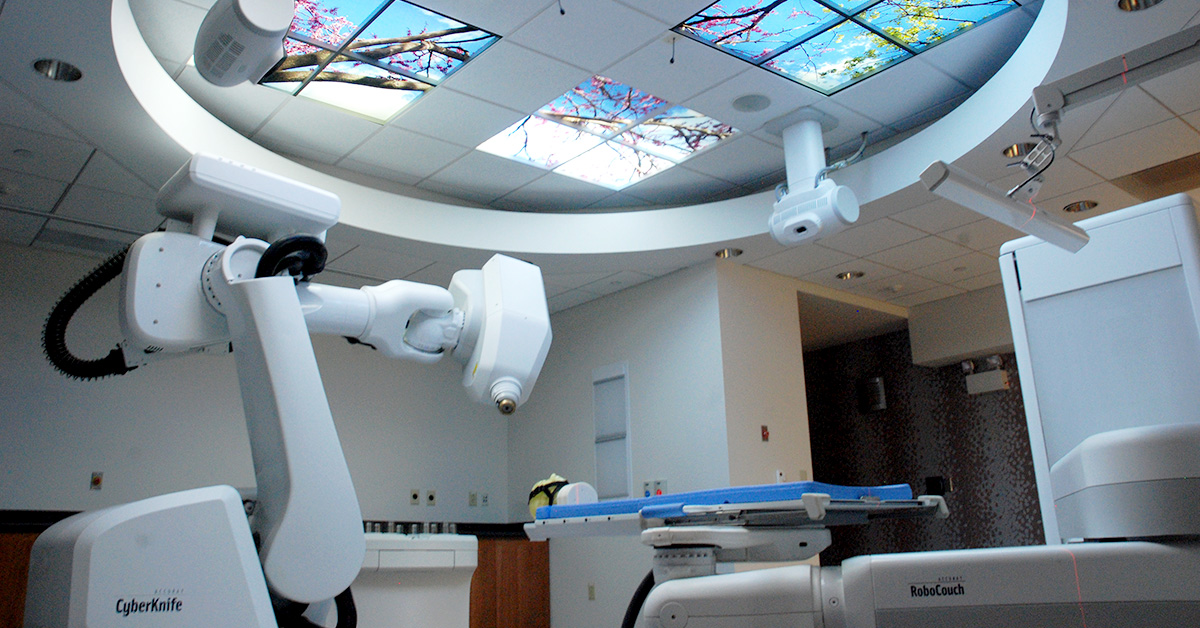
CyberKnife 101: What Cancer Patients Should Know
-
There are several different ways to administer radiation therapy, which is a type of treatment that is used to kill cancer cells. One powerful method is known as the CyberKnife.
The CyberKnife system is one way to deliver stereotactic body radiotherapy (SBRT), a form of high dose, precisely delivered radiation that can be completed in just a few sessions. Despite the name, there’s no actual surgery or incisions involved, and therapy with CyberKnife is completely noninvasive.
The CyberKnife machine uses a robotic table (which the patient lies on for treatment) and a rotating, robotic arm that moves and bends around the patient to target tumors with a high degree of precision. This precision protects surrounding healthy tissues and allows for the delivery of higher, more ablative doses of radiation than what can be given with traditional radiation techniques.
“Standard radiation that is delivered without image guidance utilizes larger margins of error around the tumor because you’re not able to target the tumor as precisely,” explained Shelly Hayes, MD, a radiation oncologist and Director of Fox Chase Cancer Center Buckingham. “By using tighter margins of error, you can increase the radiation dose because you’re not as worried about the normal tissues in the areas surrounding the tumor.”
And by giving higher doses, a patient can complete their treatment in just a handful of sessions instead of weeks of daily treatments. For patients undergoing systemic therapy as well, this can minimize breaks in that treatment.
Is CyberKnife Right for Me?
SBRT can be delivered using other radiation technologies, such as standard linear accelerators that have image guidance capabilities. However, certain tumors are better treated with the CyberKnife since it can track tumor motion in real time.
Specifically, CyberKnife is a good option for tumors that can move when a person breathes (like lung tumors and certain liver or kidney tumors) and tumors that move as a result of changes in bowel or bladder filling (like pancreatic and prostate tumors).
“For tumors that are moving, CyberKnife can track them in real time during treatment and keep the radiation confined to the tumor,” Hayes said. “If you can’t track that movement, you have to apply radiation to a larger area so you don’t miss the tumor.”
CyberKnife is also used to treat tumors in the brain or spine as an alternative to surgery or more invasive radiation treatments, like gammaknife radiation.
“The gamma knife requires placement of a metal head frame that the neurosurgeon pins onto the patient’s skull,” Hayes explained. “With CyberKnife, a plastic mesh mask is used to immobilize the patient’s head instead, which is more comfortable and convenient.”
CyberKnife Treatment at Fox Chase Cancer Center Buckingham
The CyberKnife system is an effective tool for treating several types of cancer. But, because SBRT delivers very high doses of radiation, accuracy is crucial.
“If you miss your target and inadvertently radiate the wrong area, you can cause significant damage,” Hayes said.
That’s especially true if a tumor is the same density as the surrounding normal tissues, like those in the lung, prostate, pancreas, or adrenal gland. In order for the CyberKnife to track these tumors, special metallic markers need to be inserted into the tumor prior to treatment.
“Our team can sometimes place these markers endoscopically,” Hayes said. “And not every hospital is skilled at that.”
Being treated by experienced radiation oncologists, physicists, and therapists, like the ones at Fox Chase’s Buckingham location (where our CyberKnife is located), is critically important. Having a skilled team working behind the scenes ensures that your treatment will be delivered safely.
Through years of experience with this technology, our team of specialists has built up a knowledge base of how much radiation can be given safely and effectively through this technique.
“The radiation doses that we deliver have been refined over time based on our experience and the latest literature,” Hayes said. “It’s not just about the tools—it’s also about the people who are using the tools.”
Learn more about CyberKnife at Fox Chase Cancer Center Buckingham
